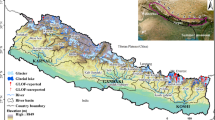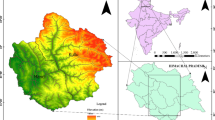Abstract
Lake Urmia is the second largest hypersaline lake in the world in terms of surface area. In recent decades, the drop in water level of the lake has been one of the most important environmental issues in Iran. At present, the entire basin is threatened due to abrupt decline of the lake’s water level and the consequent increase in salinity. Despite the numerous studies, there is still an ambiguity about the main cause of this environmental crisis. This paper is an attempt to detect the changes in the landscape structure of the main elements of the whole basin using remote sensing techniques and analyze the results against climate data with time series analysis for the purpose of achieving a more clarified illustration of processes and trends. Trend analysis of the different affecting factors indicates that the main cause of the drastic dry out of the lake is the huge expansion of irrigated agriculture in the basin between 1999 and 2014. The climatological parameters including precipitation and temperature cannot be the main reasons for reduced water level in the lake. The results show how the increase in irrigated agricultural area without considering the water resources limits can lead to a regional disaster. The approach used in this study can be a useful tool to monitor and assess the causality of environmental disaster.








Similar content being viewed by others
References
Abbaspour, M., Javid, A., Mirbagheri, S., Givi, F. A., & Moghimi, P. (2012). Investigation of lake drying attributed to climate change. International journal of Environmental Science and Technology, 9(2), 257–266.
Abbaspour, M., & Nazaridoust, A. (2007). Determination of environmental water requirements of Lake Urmia, Iran: an ecological approach. International Journal of Environmental Studies, 64(2), 161–169.
Alesheikh, A. A., Ghorbanali, A., & Nouri, N. (2007). Coastline change detection using remote sensing. International journal of Environmental Science and Technology, 4(1), 61–66. doi:10.1007/BF03325962.
Banihabib, M. E., Azarnivand, A., & Peralta, R. C. (2015). A new framework for strategic planning to stabilize a shrinking lake. Lake and Reservoir Management, 31(1), 31–43.
Benedetti, R., & Rossini, P. (1993). On the use of NDVI profiles as a tool for agricultural statistics: the case study of wheat yield estimate and forecast in Emilia Romagna. Remote Sensing of Environment, 45(3), 311–326. doi:10.1016/0034-4257(93)90113-C.
Benz, U. C., Hofmann, P., Willhauck, G., Lingenfelder, I., & Heynen, M. (2004). Multi-resolution, object-oriented fuzzy analysis of remote sensing data for GIS-ready information. ISPRS Journal of Photogrammetry and Remote Sensing, 58(3–4), 239–258. doi:10.1016/j.isprsjprs.2003.10.002.
Blaschke, T. (2010). Object based image analysis for remote sensing. ISPRS Journal of Photogrammetry and Remote Sensing, 65(1), 2–16.
Burnett, C., & Blaschke, T. (2003). A multi-scale segmentation/object relationship modelling methodology for landscape analysis. Ecological Modelling, 168(3), 233–249. doi:10.1016/S0304-3800(03)00139-X.
Cleve, C., Kelly, M., Kearns, F. R., & Moritz, M. (2008). Classification of the wildland–urban interface: a comparison of pixel-and object-based classifications using high-resolution aerial photography. Computers, Environment and Urban Systems, 32(4), 317–326.
Darwish, A., Leukert, K., & Reinhardt, W. (2003). Image segmentation for the purpose of object-based classification. In International Geoscience and Remote Sensing Symposium (Vol. 3, pp. III: 2039–2041).
Deering, D. W. (1978). Rangeland reflectance characteristics measured by aircraft and spacecraft sensors. Ph.D. dissertation, Texas A&M University. (224312611), p. 338.
Definiens (2005). eCognition developer software. Munich: eCognition Professional.
ESRI (2004). ArcGIS software. Redlands, CA: Environmental Systems Research Institute.
Farzin, S., Ifaei, P., Farzin, N., Hassanzadeh, Y., & Aalami, M. (2012). An investigation on changes and prediction of Urmia Lake water surface evaporation by chaos theory. International Journal of Environmental Research, 6(3), 815–824.
Fathian, F., Morid, S., & Kahya, E. (2015). Identification of trends in hydrological and climatic variables in Urmia Lake basin, Iran. Theoretical and Applied Climatology, 119(3–4), 443–464. doi:10.1007/s00704-014-1120-4.
Ghaheri, M., Baghal-Vayjooee, M., & Naziri, J. (1999). Lake Urmia, Iran: a summary review. International Journal of Salt Lake Research, 8(1), 19–22.
Hamed, K. H., & Rao, A. R. (1998). A modified Mann-Kendall trend test for autocorrelated data. Journal of Hydrology, 204(1), 182–196.
Hassanzadeh, E., Zarghami, M., & Hassanzadeh, Y. (2012). Determining the main factors in declining the Urmia Lake level by using system dynamics modeling. Water Resources Management, 26(1), 129–145.
ISCE (2011). Evaluating the sustainability of the development process and its impact on Urmia Lake. Tehran: Iranian Society of Consulting Engineers.
Kakahaji, H., Banadaki, H. D., Kakahaji, A., & Kakahaji, A. (2013). Prediction of Urmia Lake water-level fluctuations by using analytical, linear statistic and intelligent methods. Water Resources Management, 27(13), 4469–4492.
Karimi, N., & Mobasheri, M. R. (2011) Shoreline change analysis of Urmia Lake using multi-temporal satellite images. In Eighteenth National Conference on Geomatics, Iran, Tehran (pp. 88–96).
Kavehkar, S., Ghorbani, M. A., Khokhlov, V., Ashrafzadeh, A., & Darbandi, S. (2011). Exploiting two intelligent models to predict water level: a field study of Urmia lake, Iran. International Journal of Civil and Environmental Engineering, 3(3), 162–166.
Kendall, M. G. (1975). Rank correlation methods. New York: Oxford Univ. Press.
Khatami, S., & Berndtsson, R. (2013). Urmia Lake watershed restoration in Iran: short-and long-term perspectives. In 6th International Perspective on Water Resources & the Environment conference (IPWE 2013). Environmental & Water Resources Institute (EWRI)/American Society of Civil Engineers (ASCE).
Luo, G., Zhou, C., Chen, X., & Li, Y. (2008). A methodology of characterizing status and trend of land changes in oases: a case study of Sangong River watershed, Xinjiang, China. Journal of Environmental Management, 88(4), 775–783.
Mann, H. B. (1945). Nonparametric tests against trend, Econometrica. Econometrica, 13.
RDevelopmentCoreTeam (2005). R: a language and environment for statistical computing. Vienna, Austria: R Foundation for Statistical Computing.
Rokni, K., Ahmad, A., Selamat, A., & Hazini, S. (2014). Water feature extraction and change detection using multitemporal Landsat imagery. Remote Sensing, 6(5), 4173–4189.
Rokni, K., Ahmad, A., Solaimani, K., & Hazini, S. (2015). A new approach for surface water change detection: integration of pixel level image fusion and image classification techniques. International Journal of Applied Earth Observation and Geoinformation, 34, 226–234. doi:10.1016/j.jag.2014.08.014.
Serrano, A., Mateos, V. L., & Garcia, J. A. (1999). Trend analysis of monthly precipitation over the iberian peninsula for the period 1921–1995. Physics and Chemistry of the Earth, Part B: Hydrology, Oceans and Atmosphere, 24(1–2), 85–90. doi:10.1016/S1464-1909(98)00016-1.
Sima, S., Ahmadalipour, A., Shafiee Jood, M., Tajrishy, M., & Abrishamchi, A. (2012) Monitoring Urmia Lake area variation using MODIS Satellite data. In World Environmental and Water Resources Congress 2012 (pp. 20–24).
Sima, S., Ahmadalipour, A., & Tajrishy, M. (2013). Mapping surface temperature in a hyper-saline lake and investigating the effect of temperature distribution on the lake evaporation. Remote Sensing of Environment, 136, 374–385.
Sima, S., & Tajrishy, M. (2013). Using satellite data to extract volume–area–elevation relationships for Urmia Lake, Iran. Journal of Great Lakes Research, 39(1), 90–99. doi:10.1016/j.jglr.2012.12.013.
Tisseuil, C., Roshan, G. R., Nasrabadi, T., & Asadpour, G. (2012). Statistical modeling of future lake level under climatic conditions, case study of Urmia Lake (Iran). International Journal of Environmental Research, 7(1), 69–80.
Tucker, C., Justice, C., & Prince, S. (1986). Monitoring the grasslands of the Sahel 1984-1985. International Journal of Remote Sensing, 7(11), 1571–1581.
Tucker, C. J. (1979). Red and photographic infrared linear combinations for monitoring vegetation. Remote Sensing of Environment, 8(2), 127–150.
Tucker, C. J., Pinzon, J. E., Brown, M. E., Slayback, D. A., Pak, E. W., Mahoney, R., et al. (2005). An extended AVHRR 8-km NDVI dataset compatible with MODIS and SPOT vegetation NDVI data. International Journal of Remote Sensing, 26(20), 4485–4498.
Turner, B. L. II, Ross, R. H., & Skole, D. (1993). Relating land use/land cover and global land cover change. (Vol. No. 24 and HDP Report No. 5, IGBP of the ICSU and HDP of the ISSC). Stockholm and Geneva: IGBP Report.
UNESCO (2009). List of Biosphere Reserves which are wholly or partially Ramsar Wetlands. Official site [online], updated 21 April 2009, internet website: www.unesco.org/mab/doc/brs_ramsar.pdf. Accessed 10 Sept 2015.
Wang, S., & Wang, S. (2013). Land use/land cover change and their effects on landscape patterns in the Yanqi Basin, Xinjiang (China). Environmental Monitoring and Assessment, 185(12), 9729–9742.
WRI (2006). In S. Report (Ed.), Integrated water resources management of Urmia Lake. Tehran: Water Research Institute.
Yang, X., & Lo, C. (2003). Modelling urban growth and landscape changes in the Atlanta metropolitan area. International Journal of Geographical Information Science, 17(5), 463–488.
Yue, S., Pilon, P., & Cavadias, G. (2002). Power of the Mann–Kendall and Spearman’s rho tests for detecting monotonic trends in hydrological series. Journal of Hydrology, 259(1), 254–271.
Zha, Y., Liu, Y., & Deng, X. (2008). A landscape approach to quantifying land cover changes in Yulin, Northwest China. Environmental Monitoring and Assessment, 138(1–3), 139–147.
Author information
Authors and Affiliations
Corresponding author
Rights and permissions
About this article
Cite this article
Mehrian, M.R., Hernandez, R.P., Yavari, A.R. et al. Investigating the causality of changes in the landscape pattern of Lake Urmia basin, Iran using remote sensing and time series analysis. Environ Monit Assess 188, 462 (2016). https://doi.org/10.1007/s10661-016-5456-3
Received:
Accepted:
Published:
DOI: https://doi.org/10.1007/s10661-016-5456-3




